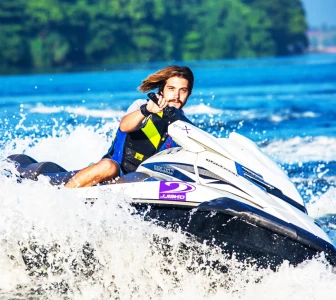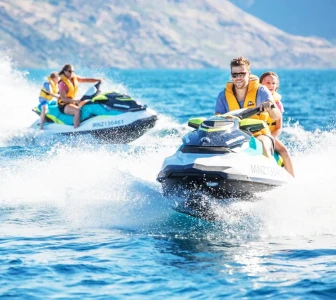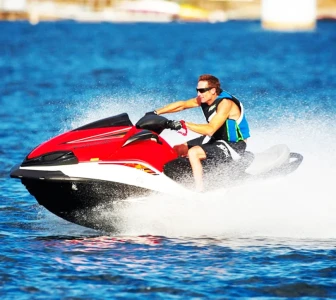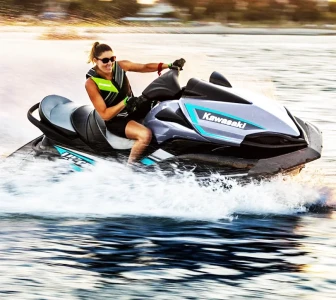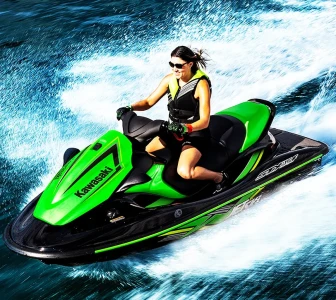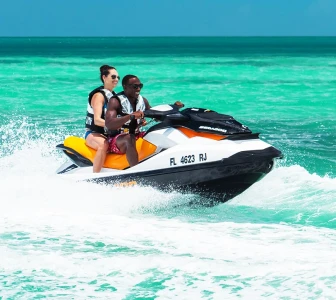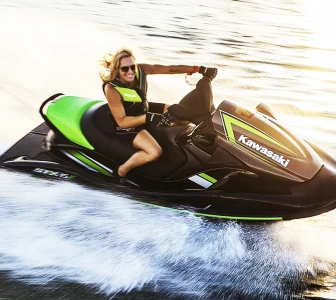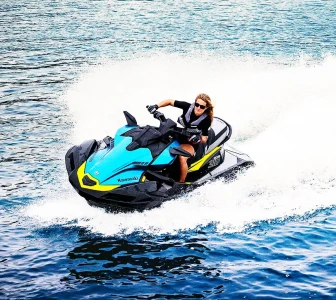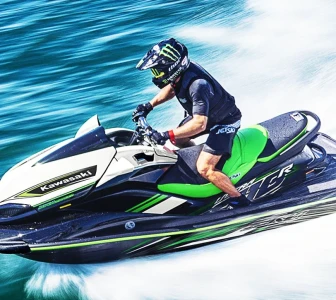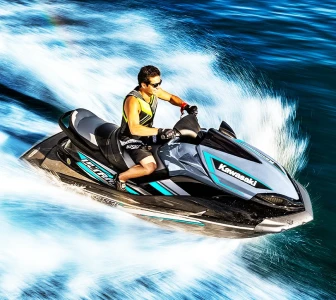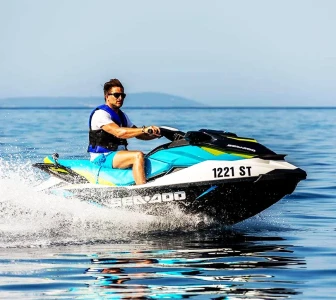Jet Ski 15 Min.
30 Minute
Free Refund
Deposit Payment
Tour Detail
Jet skiing is one of the adrenaline-filled and exciting stars of the water sports world. This activity, which offers the opportunity to glide at high speeds on the water surface, make sharp turns, and dance with the waves, is among the top choices for those seeking adventure in holiday resorts and along the coastline. Jet skiing is more than just a watercraft; it provides users with a unique experience of freedom, excitement, and unforgettable memories.
This motorized watercraft is typically designed for two or three people and can reach incredible speeds thanks to its powerful engines. Riding a jet ski requires being alert both physically and mentally. Quick reactions, maintaining balance, and adapting to the movements of the water are fundamental aspects of this activity. Therefore, jet skiing is not only an ideal option for speed enthusiasts but also for those looking to improve their coordination skills.
Jet ski activities are usually conducted within certain safety precautions and rules. A brief information session provided by professional instructors allows participants to learn the basic principles of jet ski operation and safety procedures. This session includes important information such as how to start the jet ski, speed control, turning techniques, and what to do in emergencies. Safety equipment, especially life jackets, is mandatory for each participant and must be worn throughout the tour.
The jet ski experience typically takes place on designated safe courses. These courses are specially marked to ensure the safety of other swimmers and watercraft. Participants can freely navigate within these courses, adjust their speeds, and perform exciting maneuvers on the water. Some tours may also offer short excursions in open waters for those looking to experience more adventurous moments. During these excursions, there is an opportunity to enjoy the coastline and the surrounding natural beauty from a different perspective.
The joy of using a jet ski is not limited to speed alone. The refreshing effect of the water, the warmth of the sun, and the surrounding sea view make this experience even more special. Especially in the summer months, jet skiing is a perfect way to cool off and have fun for those who are overheated. Jet ski activities that you can participate in with your friends or family can turn into an unforgettable social event thanks to the shared excitement and joy.
Renting a jet ski can usually be easily organized. In holiday resorts and popular coastal areas, many businesses offer this service. With options available for different durations and courses, everyone can experience a jet skiing adventure that suits their preference and schedule. Whether it’s a short test ride or a longer-lasting adventure, jet skiing will always remain an unforgettable memory.
What to know
There are a number of important factors to consider before riding a jet ski. These factors are crucial for ensuring your safety as well as helping you make the most of your experience. Various issues such as age limits, license requirements, safety rules, and rental conditions should be clarified before embarking on your jet ski adventure.
Age Limits and Physical Condition: In most places, there is a specific age limit to use a jet ski. This limit is generally set at 16 or 18 years old, but it can vary in some regions. Additionally, individuals intending to use a jet ski are usually expected to have good overall health. It is not recommended for individuals with health problems such as heart conditions, epilepsy, or balance issues to use a jet ski. Pregnant women are also typically prohibited from riding jet skis for safety reasons.
License Requirement: In some areas, especially for using more powerful jet skis, a special license or permit may be required. Such a requirement is usually established to regulate marine traffic and ensure that users possess a certain level of competence. Before renting, it is important to obtain information about the license or permit requirements from the relevant business or local authorities. If such a requirement exists, you should ensure that you have the necessary documents.
Safety Rules and Equipment: There are a number of basic safety rules that must be followed when using a jet ski. The most important of these is to always and properly wear a life jacket. A life jacket can be life-saving, helping you stay afloat in the event of an accident or fall. Additionally, it is crucial to adhere to designated speed limits and maintain a safe distance from other watercraft while using a jet ski. Avoiding sudden and dangerous maneuvers is necessary for both your safety and the safety of those around you. Tour operators typically provide a safety briefing, and it is important to carefully follow all the instructions stated in this briefing.
Rental Conditions and Durations: Companies that offer jet ski rental services usually provide different rental durations and conditions. The rental period can generally vary from 15 minutes to several hours. Pricing often fluctuates based on the rental duration, jet ski model, and sometimes the season. Before renting, it is important to carefully learn about the prices, rental duration, fuel policy, and any potential extra fees (such as late return fees). Additionally, reading the rental agreement to understand your rights and responsibilities can be beneficial.
Weather Conditions: Checking the weather conditions before using a jet ski is also very important. Riding a jet ski in stormy, choppy, or foggy weather can be dangerous. Therefore, you should ensure that suitable weather conditions are expected for your safety. Tour operators reserve the right to cancel or postpone tours if the weather worsens.
Liability and Insurance: It is important to understand the liability conditions for potential accidents or damages while using a jet ski. Rental companies usually offer insurance options. These insurances may cover material damages or injuries that could result from an accident. Learning about the insurance options and coverage before renting can help protect yourself against potential risks.
Environmental Awareness: Being environmentally conscious while using a jet ski is also important. You should be careful not to disturb marine life and avoid wandering unnecessarily outside designated routes. Being cautious of fuel leaks and not throwing trash into the sea is part of your environmental responsibility.
Tour Program
Jet ski tours are carefully planned to offer participants a safe and exciting experience. The tour programs usually include a short briefing session, distribution of safety equipment, and then free riding time on the designated course. Some tours may vary depending on the participants' experience levels and preferences.
Here are the typical stages of a jet ski tour:
Welcome and Registration: At the beginning of the tour, participants are welcomed at the designated meeting point. Here, general information about the tour is provided, and necessary registration processes are completed. Identity checks and contact details may be taken.
Safety Briefing: Safety is the top priority in jet ski tours. Therefore, a comprehensive safety briefing is given by experienced instructors. During this briefing, the basic controls of the jet ski (throttle, brake, steering), safety rules (speed limits, distance from other vessels, prohibited areas), the use of life jackets, and what to do in emergencies are explained in detail. Information is also provided about the boundaries of the tour course and possible hazards. Participants' questions are answered, and everyone is ensured to fully understand the safety procedures.
Equipment Distribution: After the safety briefing, life jackets of suitable size and durability are distributed to each participant. They are shown how to wear the life jackets correctly and how to securely fasten the buckles. In case of need, additional equipment such as sunglasses or waterproof cases may also be provided.
Jet Ski Introduction and Basic Controls: Instructors introduce the jet ski models to be used and demonstrate how the basic controls (throttle, steering, stop button) work practically. Basic riding techniques such as how to start the jet ski, adjust the speed, and make turns are explained. Participants may be allowed to briefly get on the jet ski to familiarize themselves with the controls (if safety conditions allow).
Free Riding on the Designated Course: After completing the information and preparation stages, participants can start using the jet skis freely on the designated safe course. Instructors usually remain in safety boats around the course to observe the participants. They can intervene immediately if any issues arise. The free riding time may vary depending on the duration of the tour and the number of participants. During this time, participants can enjoy the speed and maneuvers on the water. Some tours may offer wider or more challenging courses for more experienced users.
Break and Rest: Depending on the duration of the tour, some tours may include a short break. During this break, participants can rest, drink water, and share their experiences.
Ending the Tour and Return: At the end of the designated time, participants return their jet skis to the starting point upon the instructors' signal. The jet skis are parked safely, and the used equipment (life jackets, etc.) is collected. Participants can share their opinions about the tour and ask any questions they may have. Then, participants are directed to the starting point or to their requested transfer vehicles.
What's Included
Use of jet ski for the specified duration.
All necessary safety equipment (life jacket).
A brief safety briefing and basic usage instructions.
Generally, fuel expenses.
Supervision and guidance by experienced staff (in some cases).
Not Included
Personal expenses: Souvenirs, snacks, drinks, etc.
Photo and video shooting services: If offered by the tour operator, they are usually subject to an additional fee.
Tips: Optional for the staff.
Additional insurance: Special insurance requests that are outside the coverage of standard insurance.
Transportation (in certain cases): If transfer service is not included in the package, reaching the meeting point and return is the participant's responsibility.
Food and drinks (in certain cases): Especially short-term tours generally do not include food and drinks.
What to bring with you?
Swimsuit or bikini: A must-have since you'll be entering the water.
Towel: For drying off.
Sun cream: A high SPF cream to protect your skin from the harmful effects of the sun.
Hat or bandana: To protect your head from the sun.
Sun glasses: To protect your eyes from the sun's glare (make sure they are securely worn to avoid falling off, or use a neck strap).
Waterproof bag or case: To protect your valuables like phone and wallet from water.
Extra clothes: Dry clothes you can wear after the tour.
Cash or credit card (for additional expenses).
Languages on tour
English
Turkish
Comments (0)
